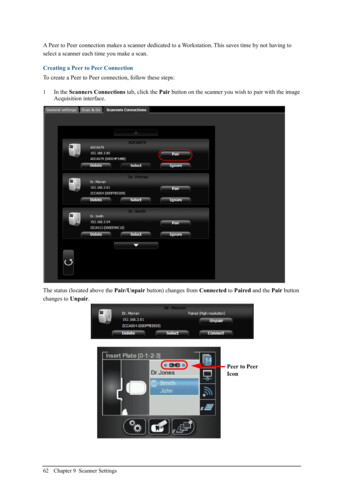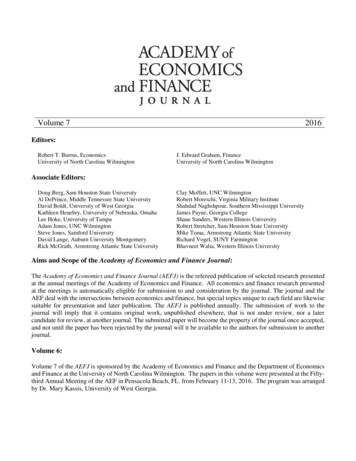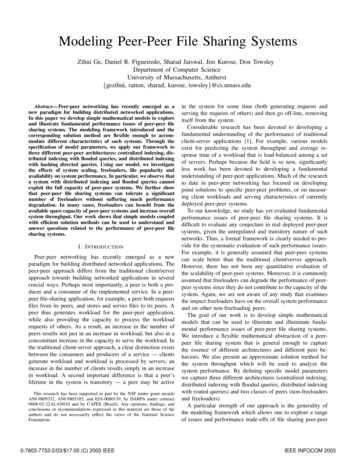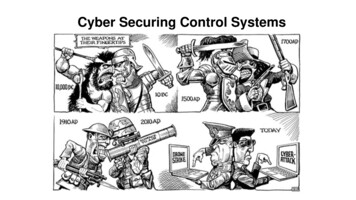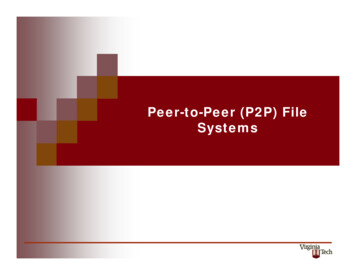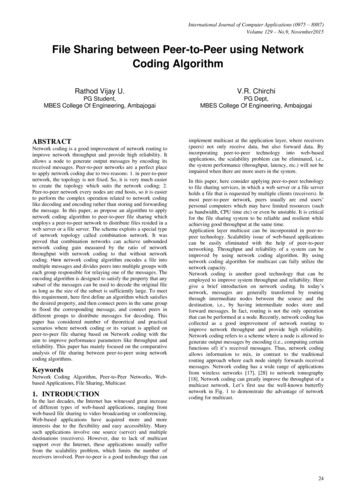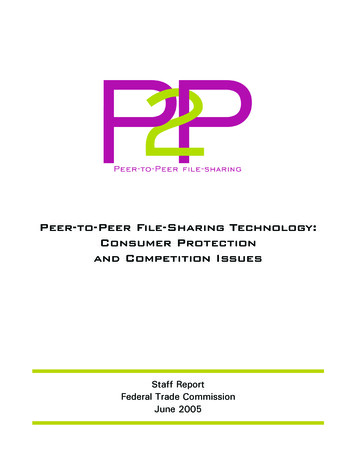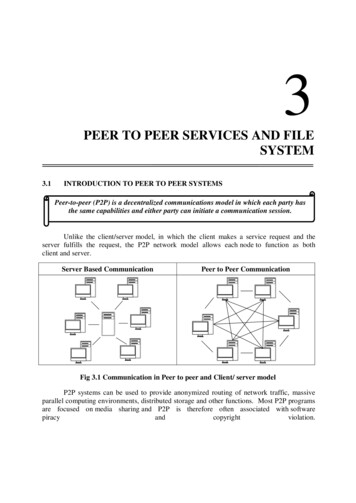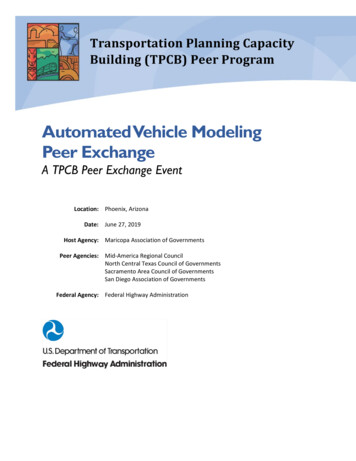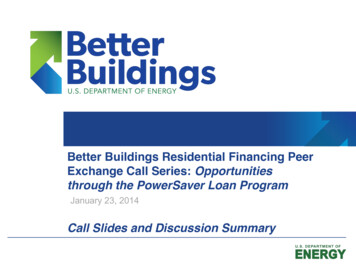
Transcription
2 Title SlideBetter Buildings Residential Financing PeerExchange Call Series: Opportunitiesthrough the PowerSaver Loan ProgramJanuary 23, 2014Call Slides and Discussion Summary
Agenda Call Logistics and Introductions BBRN and Peer Exchange Call Overview Featured Speakers Department of Housing and Urban Development (HUD)National Renewable Energy Lab (NREL)Efficiency Maine Discussion Future Call Topics Poll2
Call ParticipantsAFC FirstAustin, TXBoulder, COBurlington, VTChicago, ILClinton FoundationCraft3Department of Housing andUrban Development (HUD) Institute for MarketTransformation Los Angeles, CA Maine 3 National Renewable Energy Lab(NREL) New Orleans, LA Nevada Philadelphia, PA Seattle, WA Spirit Foundation Texas Veterans Land Board
Better Buildings Residential Network Better Buildings Residential Network: Connects energy efficiency programs andpartners to share best practices to dramatically increase the number of Americanhomes that are energy efficient. Membership: Open to organizations committed to accelerating the pace of existing residentialupgrades. Commit to providing DOE with annual number of residential upgrades, and informationabout benefits associated with them. Benefits: Peer Exchange CallsTools, templates, & resourcesNewsletter updates on trends Recognition: Media, materialsOptional benchmarkingResidential Solution CenterFor more information & to join, email bbresidentialnetwork@ee.doe.gov. Better Buildings Residential Network Group on Home Energy ProsJoin to access: Peer exchange call summaries and calendarDiscussion threads with energy efficiency programs and partnersResources and documents for energy efficiency programs and -buildings-residential-network4
Better Buildings Residential NetworkGroup on Home Energy Pros Website5
Peer Exchange Call Series There are currently 6 Peer Exchange call series: Data & EvaluationFinancing & RevenueMarketing & Outreach Multi- ‐Family/ Low Income HousingProgram SustainabilityWorkforce/ Business Partners Calls are held the 2nd and 4th Thursday of every month at 12:30and 3:00 ET Upcoming calls: Feb 13: Program Sustainability - Energy Efficiency Program Models for Local GovernmentFeb 13: Data & Evaluation - Cost-Effectiveness Tests and Measuring Like a UtilityFeb 27: How Can the Network Meet Your Needs?Feb 27: Marketing & Outreach - Using Social Media for Long Term Branding Send call topic ideas or requests to be added to additional callseries distribution lists to peerexchange@rossstrategic.com.6
Featured Speaker: Department ofHousing and Urban Development (HUD)
FHA PowerSaver U.S. DEPARTMENT OF HOUSING AND URBAN DEVELOPMENTFHA HOME ENERGY IMPROVEMENT LOAN PILOT PROGRAMJANUARY 23, 20148
HOME ENERGY IMPROVEMENTSThe need for affordable financing¾Helping homeowners make money-saving home energyimprovements is a top priority of the Administration.¾Home energy improvements can save familieshundreds of dollars a year -- while creating jobs andreducing pollution.¾More home owners want to make home energyimprovements, according to industry forecasts.¾But a lack of affordable, available financing remains amajor barrier for many consumers.¾A market need exists for a financing option.9
KEY FEATURES OF POWERSAVER¾&RQJUHVV DSSURSULDWHG RI 0 WR ) ·V 6LQJOH )DPLO\ WR catalyze innovations in the residential energy efficiencysector.¾FHA provides mortgage insurance to protect lenders in eventof loan default.¾Grant incentives for lenders to participate and lower costsfor consumers.¾Two FHA PowerSaver programs:1) Title I PowerSaver FHA insures up to 90% of a Title I loan. 2) Title II PowerSaver 203(k) FHA insures up to 100% of Title II loan10
TITLE I POWERSAVER HIGHLIGHTS¾¾Loans amounts up to 25,000 ( 7,500 unsecured)Primarily a second trust loan program, but Can be in first positionCan be in third position only when the second trust was made forWKH KRPH·V SXUFKDVH 7KHUH DUH RWKHU H[FHSWLRQV ¾Use of loan funds: Minimum 75% of loan proceeds must be used for energysaving improvements. Maximum 25% of loan proceeds can be used for most otherimprovements.¾Appraisal is not required Lenders may choose to require an appraisal according to theirinvestor or risk requirements.
TITLE II POWERSAVER 203(K) HIGHLIGHTS¾203(k) ² refers to the section of the National HousingAct that authorizes FHA to insure loans for rehabilitatinghousing stock.¾Under 203(k), borrowers can get an FHA mortgage for:99the purchase or refinance of a home, pluscosts to rehab or improve the home.¾First trust lien position only¾/RDQ EHFRPHV D 3RZHU6DYHUµ ORDQ ZKHQ DW OHDVW 3,500 of the home improvement project includesenergy efficient improvements.
ELIGIBLE USES OF GRANT FUNDS INCLUDEBorrower¾ Energy audit, if borrower desires Audit is not required Auditor must be accredited for HERS or BPI Auditor can be the contractor¾ Loan origination fee¾ Property appraisal if lender requires Lender¾ Program marketing expenses13
TITLE I POWERSAVER ATTRIBUTESAttributeEligibleLoan Amount Maximum 25,000 (unsecured 7,500)Loan Term 15-years (standard energy improvements) 20-years (renewable energy improvements)Combined-Loan-to-Value Not Required (Some lenders may still require)Appraisal Type Not Required (Some lenders may still require)Property Types Single Family detached Attached dwellings CondominiumsIneligible: Co-operatives Manufactured HomesNumber of Units One14
TITLE I POWERSAVER ATTRIBUTESAttributeEligibleOccupancy Owner-occupiedIneligible Second Homes Non-Owner-OccupiedBorrower Ownership 50 % interest minimumDecision Credit Score 660 minimumDebt-to-Income Ratio 45% maximum (compensating factors allowed tooffset)Use of Proceeds Measures that improve KRPH·V HQHUJ\ performance (min 75% of loan proceeds) Other Home Improvements (25% of proceeds)Disbursement of Proceeds 50% maximum at closing 50% upon completion of the workDiscount Points Third parties may pay and Must be bona fide15
TITLE II POWERSAVER 203(K) ATTRIBUTESAttributeEligibleProperty types 1-4 family dwelling Condominiums (1-unit only) Manufactured homes built after 1978 Mixed use business square foot limitsfor business apply. an 25%, floor, Properties must have been completedfor at least a period of 1 year.Standard (k) Major Improvements Lender must use HUD 203(k)consultant Minimum repair - 5,000Streamline (k) Minor Improvements Maximum improvement project 35,000 HUD 203(k) consultant is not required Improvements may not be structural
FHA PpOoWwEeRrSsAaVvEeRr - Eligible Improvements I mprovementStandardsWhole HouseWhole house air sealing measures, including interior and exterior measures, utilizing sealants, caulks, insulating foams,gaskets, weather-stripping, mastics, and other building materials in accordance with BPI standards or other proceduresapproved by the Secretary. (Reference: http://www.bpi.org/standards.aspx )I nsulation:AtticAttic insulation measures that-(A) include sealing of air leakage between the attic and the conditioned space, in accordance with BPI standards or theattic portions of the DOE or EPA thermal bypass checklist or other procedures approved by the Secretary;(B) add at least R-19 insulation to existing insulation;(C) result in at least R-38 insulation in DOE climate zones 1 through 4 and at least R-49 insulation in DOE climatezones 5 through 8, including existing insulation, within the limits of structural capacity, except that a State, with theapproval of the Secretary, may designate climate zone subregions as a function of varying elevation; andMap Page: http://www.energystar.gov/index.cfm?c home sealing.hm improvement insulation tableI nsulation:WallI nsulation:Crawl Space(D) cover at least-(i) 100 percent of an accessible attic; or(ii) 75 percent of the total conditioned footprint of the house.(BPI Standards reference: http://www.bpi.org/standards.aspx )Wall insulation that-(A) is installed in accordance with BPI standards or other procedures approved by the Secretary;(B) is to full-stud thickness or adds at least R-10 of continuous insulation; and(C) covers at least 75 percent of the total external wall area of the home.( BPI Reference: http://www.bpi.org/standards.aspx )Crawl space insulation or basement wall and rim joist insulation that is installed in accordance with BPI standards orother procedures approved by the Secretary and-(A) covers at least 500 square feet of crawl space or basement wall and adds at least-(i) R-19 of cavity insulation or R-15 of continuous insulation to existing crawl space insulation; or(ii) R-13 of cavity insulation or R-10 of continuous insulation to basement walls; and(B) fully covers the rim joist with at least R-10 of new continuous or R-13 of cavity insulation.Duct Sealing(BPI Reference: http://www.bpi.org/standards.aspx )Duct sealing or replacement and sealing that-(A) is installed in accordance with BPI standards or other procedures approved by the Secretary; and(B) in the case of duct replacement and sealing, replaces and seals at least 50 percent of a distribution system of thehome.(BPI Reference: http://www.bpi.org/standards.aspx )17
FHA PpOoWwEeRrSsAaVvEeRr - Eligible Improvements StandardsI mprovementSkylight ReplacementDoor or skylight replacement that meets most recent Energy Star specificationsDoor ReplacementDoor or skylight replacement that meets most recent Energy Star specificationsWindow Replacement Replacement windows that meet:(A) most recent Energy Star specifications (good)(B) meet specifications of Department of Energy High Performance Windows Volume Purchase Program (better - moreefficient)Reference: epurchase/Storm Windowsor DoorsStorm windows or doors thaty meet most recent Energy Star specifications (good), ory comply with Department of Energy Low-E volume Purchase Program (better - more efficient)Heating SystemGas/Propane/OilBoiler / FurnaceAir ConditionerHeating system replacement that meets most recent Energy Star specifications.GeothermalHeating or cooling system replacement with an Energy Star qualified geothermal heat pump that meets Tier 2 efficiencyrequirements and that is installed in accordance with ANSI/ACCA Standard 5 QI-2007.Water HeaterReplacement of a natural gas, propane, or electric water heater(gas, propane, electric,tankless)Water Heater (solar)that meets most recent Energy Star specifications.Fuel CellsandM icroturbine SystemsEfficiency of at least 30% and must have a capacity of at least 0.5 kW.Solar Panels(Photovoltaic Systems)Photovoltaic systems must provide electricity for the residence, and must meet applicable fire and electrical coderequirement.Wind TurbineResidentialA wind turbine collects kinetic energy from the wind and converts it to electricity that is compatible with a home's electricalsystem, andAir-source air conditioner or air-source heat pump replacement with a new unit that meets most recent Energy Starspecifications.Solar water heating property must be Energy Star Qualified, or certified by the Solar Rating and Certification Corporation orby comparable entity endorsed by the state in which the system is installed.Has a nameplate capacity of no more than 100 kilowatts.RoofsMetal & AsphaltMetal or asphalt roofs that meet most recent Energy Star specifications18
RESOURCES¾Title I & PowerSaver Home Pagehttp://www.hud.gov/offices/hsg/sfh/title/ti home.cfm¾Title II PowerSaver 203(k)http://portal.hud.gov/hudportal/HUD?src /program offices/housing/sfh/203k/203kmenu¾ Email your questions to:FHAPowerSaver@hud.gov19
Featured Speaker: National RenewableEnergy Lab (NREL)
Financing Opportunities throughPowerSaver Loan ProgramJanuary 23, 2014Presentation for Better BuildingsNeighborhood Program Partners andBetter Buildings Residential Network21 Energy Efficiency and Renewable Energyeere.energy.gov
PowerSaver Loan: Market Opportunities and Advantages PowerSaver loan terms (up to 20 years) of any homeimprovement loan product. Long terms mean lower monthly payments. Traditional home improvement loans are for 5 or maybe 7 years.Some products may go longer but none goes out as far as 20 years. PowerSaver loan rates are comparable to other homeimprovement loan products. Rates are in mid- ‐single digits - ‐ not as good as some moreincentivized or subsidized rates, but still good. PowerSaver has one of the highest quality loan insurers inthe world standing behind it. FHA insures the loans This provides significant credibility to the loan product22
K WĂƌƚŶĞƌƐŚŝƉ ǁŝƚŚ ,h ͛Ɛ WŽǁĞƌ ĂǀĞƌ ŽĂŶ WƌŽŐƌĂŵ HUD- ‐DOE Interagency Agreement was established to supportPowerSaver loan utilization and local market capacity, seeking to: Boost PowerSaver loan volume by providing support to HUDapproved PowerSaver lenders Promote the availability of PowerSaver to interested borrowers, byestablishing partnerships with existing energy programs, such asHome Performance with ENERGY STAR Program Sponsors and BetterBuildings Neighborhood Program recipients and contractors DOE Team Supporting PowerSaver Loan Program 23DOE Residential Buildings Integration TeamNational Renewable Energy Laboratory (NREL)Harcourt Brown & Carey, Inc.SRA International, Inc.
Working with PowerSaver:HPwES, Better Buildings Residential Network Partners Partnership will help: Develop partnerships with PowerSaver lenders Match the best qualities of PowerSaver to your programmatic goals Integrate a financing product with your broader EE or solarprogrammatic efforts. Support efforts to drive demand through marketing and outreach Provide analysis and data on the benefits of home energy upgradesPowerSaver loans Activities Webinar series for program sponsors and lenders Focused partnerships with residential programs (HPwES, BBRN) Research new opportunities and innovative approaches24
Program Example: Efficiency Maine
1/23/2014Efficiency MaineUse of Energy EfficiencyFinancing to Support SolarInstallations
Efficiency Maine Introduction1. 5XQV 0DLQH¶V HQHUJ\ HIILFLHQF\ DQG UHQHZDEOH 2.3.27energy programs.Established by the Maine Legislature in 2002 withmandate to reduce energy costs, help theenvironment, and promote sustainable economicdevelopmentFunded by: electric rate payers ODUJH IRVVLO IXHO SRZHU SODQW SROOXWLRQ ³DOORZDQFHV Federal grants ISO- 1( SRZHU JULG IRU ³negawatts
Renewable Energy Federal Tax Credits OnlyFunds for renewable installation rebates from Maine were fullyallocated in July 2013.SBC Revenue stream was allowed to sunset in December 2010. 1.4M ARRA SEP used to support rebates in 2011 and 2012.Since end of rebate program Efficiency Maine supportingrenewable energy installations through financing.28
Energy Loans1. Subordinate PACE2. PowerSaver3. New Unsecured Energy Loans 4.99- 5.99% APRNo closing or prepayment feesUp to 10, 15, and 20 year term loans with solar1- 4 unit propertiesAny HESP- qualified improvement that includes an energyDVVHVVPHQW DQG KRXUV RI DLU VHDOLQJup to 25,000 secured / up to 15,000 unsecured 10,000 costs only 80/month29
Energy Loans Start of PACE and PowerSaver in 2011 and 2012 603 loans funded to date Total 7.6M portfolio 28 energy efficiency projects included solar PV and thermalPathways to eligible work scope:1. 20% minimum projected savings from energy model2. Audit plus basic air sealing plus solar thermal or PV3. Solar PV 3kw min air source heat pump HSPF 1030
Energy Loan Comparison31
General Contact Informationefficiencymaine.com866- 376- 2463866- ES- MAINE32
Attributes of a Successful FinancingProgram Incentives that lower the amount homeowners have to pay out ofpocket relieves barriers to participation. Examples include coveringupfront costs related to administering a loan or allowing residents to rollthe cost of a home energy assessment in with their loan for energyefficiency upgrades. Some programs have found homeowners appreciate the opportunity topay off a loan over a longer time period and that the time period mattersmore than the interest rate as long as the interest rate is fair. The maximum you can lend has an impact on how much homeownerswill borrow; often homeowners will borrow close to the maximum youcan lend.33 Partnerships such as the one between the Local Energy AllianceProgram (LEAP), Charlottesville, VA and the University of VirginiaCommunity Credit Union are effective for administering a PowerSaverloan.
Discussion Highlights PowerSaver allows 50% of funds be dispersed up front,in some states there are restrictions to the amount thatcan be dispersed up front. To accommodate multiple contractors receiving paymentfor services, it is possible to disperse multiple checks inthe case of secured funds. Loans start to finish take1-2 months on average forprocessing. The library resource on the Efficiency Maine websiteincludes evaluation reports on loan programs that detailthe spill over impacts of offering these products.34
Future Call Topics Poll Results Which, if any, of the following topics are of interest forfuture Financing calls? Expanding PACE (29%) Effective loan program design and integration with contractors(57%) Packaged loan sales (43%) Options for unsecured debt (57%) Project performance relative to loan performance (71%)Please send other suggested topics topeerexchange@rossstrategic.com35
¾FHA provides mortgage insurance to protect lenders in event of loan default. ¾Grant incentives for lenders to participate and lower costs for consumers. ¾Two FHA PowerSaver programs: 1) Title I PowerSaver FHA insures up to 90% of a Title I loan. 2) Title II PowerSaver 203(k) FHA insures up to 100% of Title II loan 10
